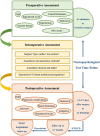Identification of individuals at risk for postoperative cognitive dysfunction (POCD)
- PMID: 35992893
- PMCID: PMC9386869
- DOI: 10.1177/17562864221114356
Identification of individuals at risk for postoperative cognitive dysfunction (POCD)
Abstract
Postoperative cognitive dysfunction (POCD) is common, occurring in around 10-54% of individuals within first few weeks after surgery. Although the majority of POCD is less commonly persistent later than 3 months following surgery, the condition increases length of stay (LOS), mortality and long-term cognitive decline, raising the need for a broad screening to identify individuals at risk for POCD during the perioperative period. In this narrative review, we summarize preoperative, intraoperative and postoperative risk factors for POCD reported in last 5 years and discuss neuropsychological tools and potential biomarkers and time points for assessment that might be suitable for clinical use. We aim to provide crucial information for developing a strategy of routine screening for POCD, which may assist with better identification of at-risk individuals for early interventions. Very importantly, the utilization of a standardized strategy may also allow higher consistency and comparability across different studies.
Keywords: assessment; postoperative cognitive dysfunction; risk factor; screening; tool.
© The Author(s), 2022.
Conflict of interest statement
Competing interests: The authors declare that there is no conflict of interest.
Figures

Similar articles
-
Postoperative Cognitive Dysfunction and Noncardiac Surgery.Anesth Analg. 2018 Aug;127(2):496-505. doi: 10.1213/ANE.0000000000003514. Anesth Analg. 2018. PMID: 29889707 Review.
-
Insulin Resistance Predicts Postoperative Cognitive Dysfunction in Elderly Gastrointestinal Patients.Front Aging Neurosci. 2019 Aug 8;11:197. doi: 10.3389/fnagi.2019.00197. eCollection 2019. Front Aging Neurosci. 2019. PMID: 31440156 Free PMC article.
-
Cognitive dysfunction after fast-track hip and knee replacement.Anesth Analg. 2014 May;118(5):1034-40. doi: 10.1213/ANE.0000000000000194. Anesth Analg. 2014. PMID: 24781572
-
The research progress of perioperative non-pharmacological interventions on postoperative cognitive dysfunction: a narrative review.Front Neurol. 2024 May 1;15:1369821. doi: 10.3389/fneur.2024.1369821. eCollection 2024. Front Neurol. 2024. PMID: 38751891 Free PMC article.
-
Preoperative 6-Minute Walk Distance Is Associated With Postoperative Cognitive Dysfunction.Ann Thorac Surg. 2018 Aug;106(2):505-512. doi: 10.1016/j.athoracsur.2018.03.010. Epub 2018 May 10. Ann Thorac Surg. 2018. PMID: 29754693
Cited by
-
The impact of cognitive reserve on delayed neurocognitive recovery after major non-cardiac surgery: an exploratory substudy.Front Aging Neurosci. 2023 Nov 23;15:1267998. doi: 10.3389/fnagi.2023.1267998. eCollection 2023. Front Aging Neurosci. 2023. PMID: 38076537 Free PMC article.
-
Opioid-free anaesthesia with dexmedetomidine and lidocaine versus remifentanil-based anaesthesia in cardiac surgery: study protocol of a French randomised, multicentre and single-blinded OFACS trial.BMJ Open. 2024 Jun 3;14(6):e079984. doi: 10.1136/bmjopen-2023-079984. BMJ Open. 2024. PMID: 38830745 Free PMC article.
-
Postoperative neurocognitive disorders in the elderly: how can we stop the harm? A literature review.Front Med (Lausanne). 2025 Mar 6;12:1525639. doi: 10.3389/fmed.2025.1525639. eCollection 2025. Front Med (Lausanne). 2025. PMID: 40115783 Free PMC article. Review.
-
Electroacupuncture Prevent and Treat Perioperative Cognitive Impairment in Elderly Patients Undergoing Hip Surgery: A Protocol for a Randomized Controlled Trial.J Pain Res. 2025 Jun 28;18:3289-3297. doi: 10.2147/JPR.S511236. eCollection 2025. J Pain Res. 2025. PMID: 40606589 Free PMC article.
-
17β-Estradiol Ameliorates Postoperative Cognitive Dysfunction in Aged Mice via miR-138-5p/SIRT1/HMGB1 Pathway.Int J Neuropsychopharmacol. 2024 Dec 1;27(12):pyae054. doi: 10.1093/ijnp/pyae054. Int J Neuropsychopharmacol. 2024. PMID: 39520138 Free PMC article.
References
-
- Needham MJ, Webb CE, Bryden DC. Postoperative cognitive dysfunction and dementia: what we need to know and do. Br J Anaesth 2017; 119: i115–i125. - PubMed
-
- Paredes S, Cortinez L, Contreras V, et al.. Post-operative cognitive dysfunction at 3 months in adults after non-cardiac surgery: a qualitative systematic review. Acta Anaesthesiol Scand 2016; 60: 1043–1058. - PubMed
-
- Evered L, Scott DA, Silbert B, et al.. Postoperative cognitive dysfunction is independent of type of surgery and anesthetic. Anesth Analg 2011; 112: 1179–1185. - PubMed
Publication types
LinkOut - more resources
Full Text Sources
Other Literature Sources

